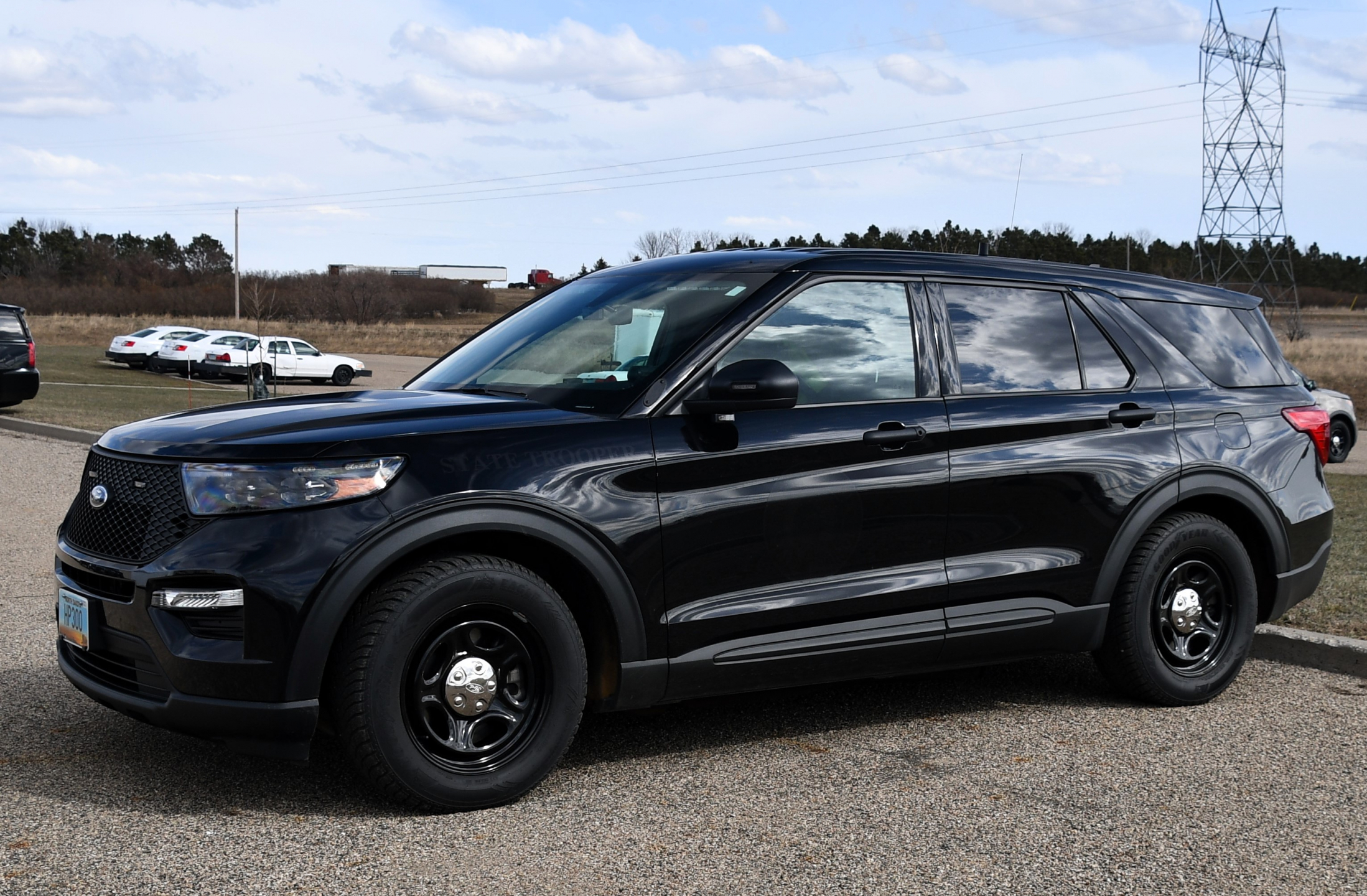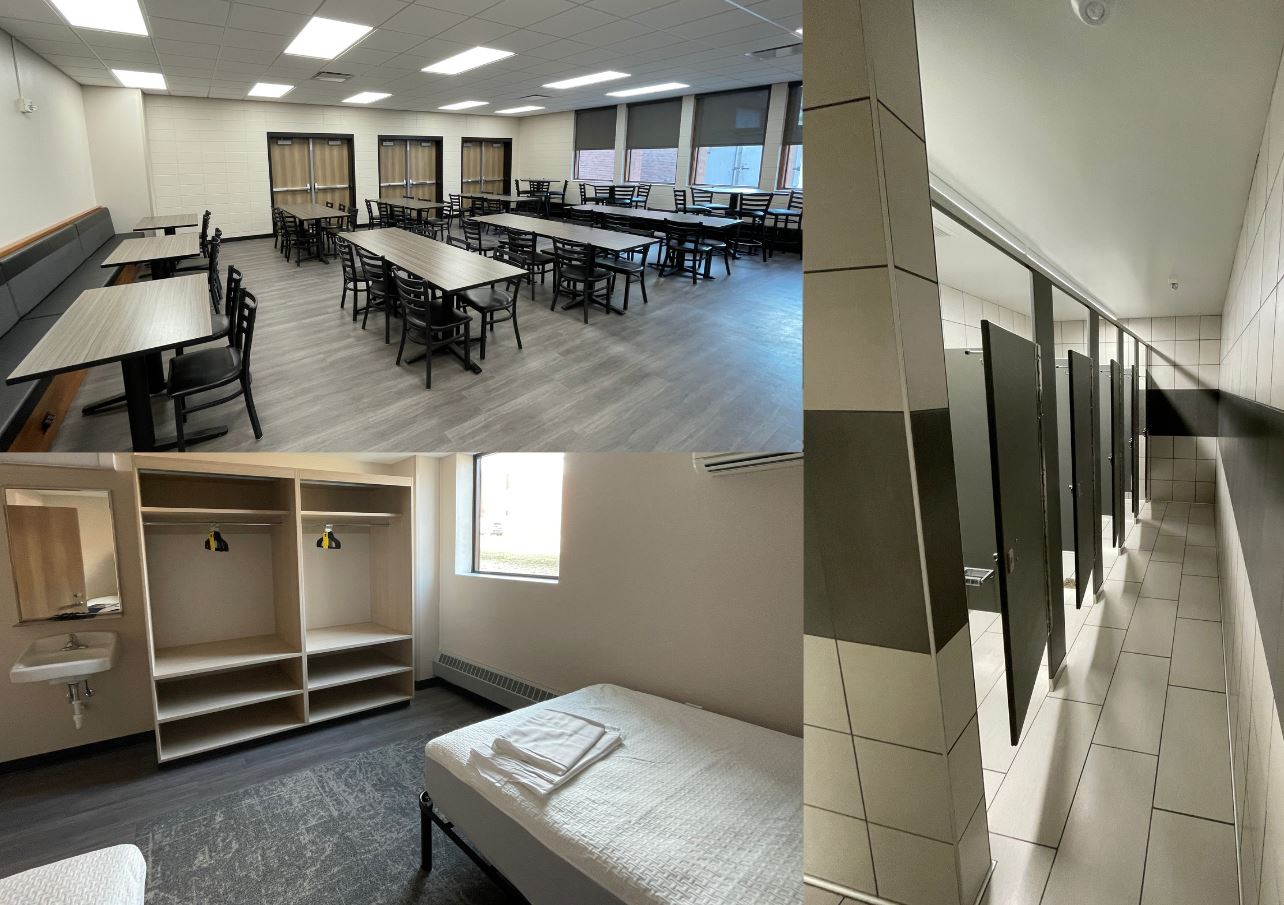NDHP Leadership
Colonel Daniel Haugen-Superintendent
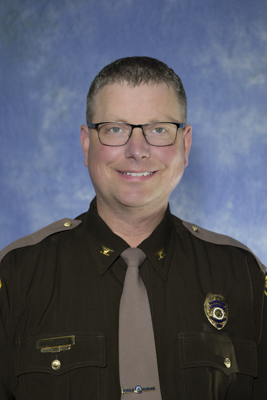
Colonel Daniel Haugen began his career with the North Dakota Highway Patrol in 2000 as a trooper stationed in Crosby before transferring to Bottineau. In 2008 he was promoted to a regional sergeant in Devils Lake. He also served as a regional sergeant in Dickinson and Bismarck. In 2014 he was promoted to the rank of lieutenant and served as the Training Director at the LETA in Bismarck where he served until May 2023 when he was named the Commander of the Southwest Region. On November 27, he was appointed Superintendent by Governor-elect Kelly Armstrong.
Haugen received an Associate Degree in Criminal Justice from Bismarck State College and a certificate in police management in 2009 from Northwestern University’s School of Police Staff and Command. Haugen served four years in the U. S. Marine Corps including service as a military police officer in Okinawa, Japan, and Camp Pendleton, California.
Major Tom Iverson: Assistant Superintendent-Field Operations
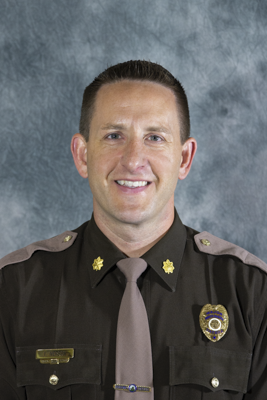
Major Tom Iverson began his career with the North Dakota Highway Patrol in 2004. He was promoted to regional sergeant in 2010 and appointed as the agency’s Safety and Education Officer in 2012. He was promoted to the rank of Lieutenant in 2014 and to the rank of Captain in 2017 where he served as the Support Services Division Commander. He was promoted to the rank of Major in 2018, where he currently serves as the agency’s Assistant Superintendent-Field Operations.
Iverson earned a Bachelor of Arts degree in Criminal Justice from Jamestown College. He is a 2012 graduate of Leadership in Police Organizations and a 2016 graduate of the Northwestern University’s School of Police Staff and Command. He also earned a Master's Degree in Management from the University of Mary.
Major Derek Arndt: Assistant Superintendent-Administration
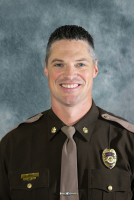
Major Derek Arndt graduated from the Law Enforcement Training Academy in June 2007. Initially stationed in Bismarck as a traffic enforcement trooper, he was promoted to Sergeant and transferred to Minot in January 2014 where he served as a Regional Sergeant. He transferred to the Law Enforcement Training Academy (LETA) and served as a Field Training Officer from August 1, 2014, until July 31, 2021. In August 2021, he was named the Criminal Interdiction Sergeant for the newly-formed Criminal Interdiction Team. In December 2021, Arndt was promoted to Lieutenant and served as the Northwest Regional Commander in Minot; then transferred to Bismarck to serve as the Southwest Regional Commander. In April 2023 he was named Deputy Operations Commander. In October of that year, he was promoted to Captain and served as the agency’s Administrative Services Division Commander. On July 1, 2025, Arndt was promoted to Major where he currently serves as Assistant Superintendent-Administration. Arndt received a Bachelor of Science degree in Criminal Justice from North Dakota State University in 2006 and is a 2015 graduate of Leadership in Police Organizations.
North Dakota Highway Patrol History
1935 - Organization of Highway Patrol
The North Dakota Highway Patrol was created when the 1935 Legislative Assembly gave the state highway commissioner, with the consent of the governor, authority to appoint a state highway patrol superintendent and assistant superintendent.
1936 - First Patrol - Five Patrol Officers
The state highway patrol superintendent was authorized and empowered to appoint not more than 10 persons to constitute such state highway patrol to be known as "Highway Police." Five men were appointed with a duty to enforce North Dakota laws relating to the protection and use of public highways in the state and the operation of motor and other vehicles upon said highways. These highway patrol officers were vested with all the powers and performance of duties held and performed by peace officers in North Dakota. The jurisdiction of the officers extended throughout the state.
1936 - Increase to Eight Patrol Officers
In 1936, three additional men were added to the regular staff, bringing the staff total to eight.
1937 - Increase to 12 Patrol Officers
In 1937 the staff was increased to 12 patrolmen, including the superintendent, which filled the quota allowed by the 1935 Legislative Assembly.
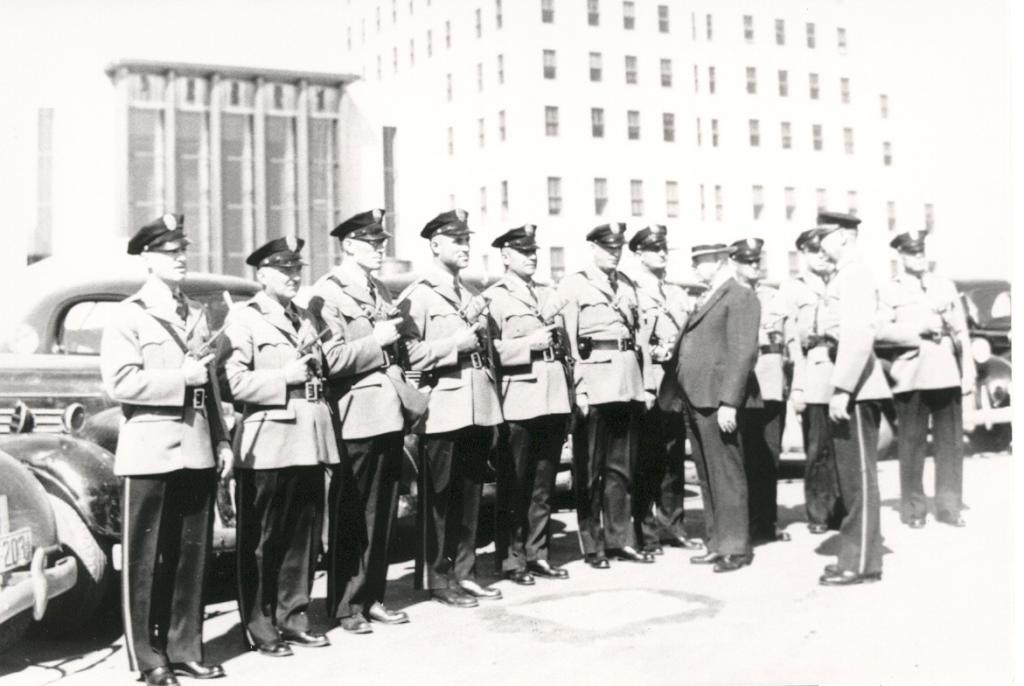
1941 - Increase to 20 Patrol Officers
The 1941 Legislative Assembly authorized the Patrol to be increased to 20 men, including the superintendent and assistant superintendent.
1947 - Increase to 42 Patrol Officers
The authorized strength of the Patrol was increased to 42 uniformed officers.
1947 - Driver's Examinations
A law was passed making it necessary for all new drivers to take a driver's examination and the responsibility to conduct these examinations fell on the shoulders of the Highway Patrol. Examinations were scheduled and were given throughout the state at strategic places once or twice a month. These examinations included a test of the applicant's eyesight; the ability to read and understand highway signs regulating, warning, and directing traffic; knowledge of the traffic laws of this state; and an actual demonstration of the ability to exercise ordinary and reasonable control in the operation of a motor vehicle.
1951 - Highway Patrol Directly Responsible to the Governor
The 1951 Legislature gave the power of appointment of the superintendent and assistant superintendent directly to the governor. It was also mandated each patrolman be bonded by the state and each carry a badge of authority "with the seal of the state in the center thereof;" the words "North Dakota Highway Patrol" emblazoned around the border.
1955 - Increase to 51 Patrol Officers
The 1955 Legislature authorized an additional increase in staff, and after comprehensive written and oral examinations were given to approximately 150 applicants, nine men were selected as patrolmen and reported for duty July 1, 1955.
1955 - State Divided into Districts and Sergeants Appointed
The 1955 Legislative Assembly gave the superintendent of the Highway Patrol power to set up districts as deemed necessary and to designate ranks lower than assistant superintendent. Subsequently, the state was divided into eight districts and a sergeant appointed to supervise the work of the men in each district. This has proved invaluable in coordinating work in the field and the state officers.
1957 - Increase to 68 Patrol Officers
The 1957 Legislature granted an increase to 17 men to the Patrol, thereby making the total strength 68. Five of these officers were provided when the department was given the additional responsibility of enforcing Public Service Commission regulations.
1959 - Increase to 78 Patrol Officers
The 1959 Legislature authorized an additional 10 patrol officers resulting in a departmental total of 78 sworn uniformed officers.
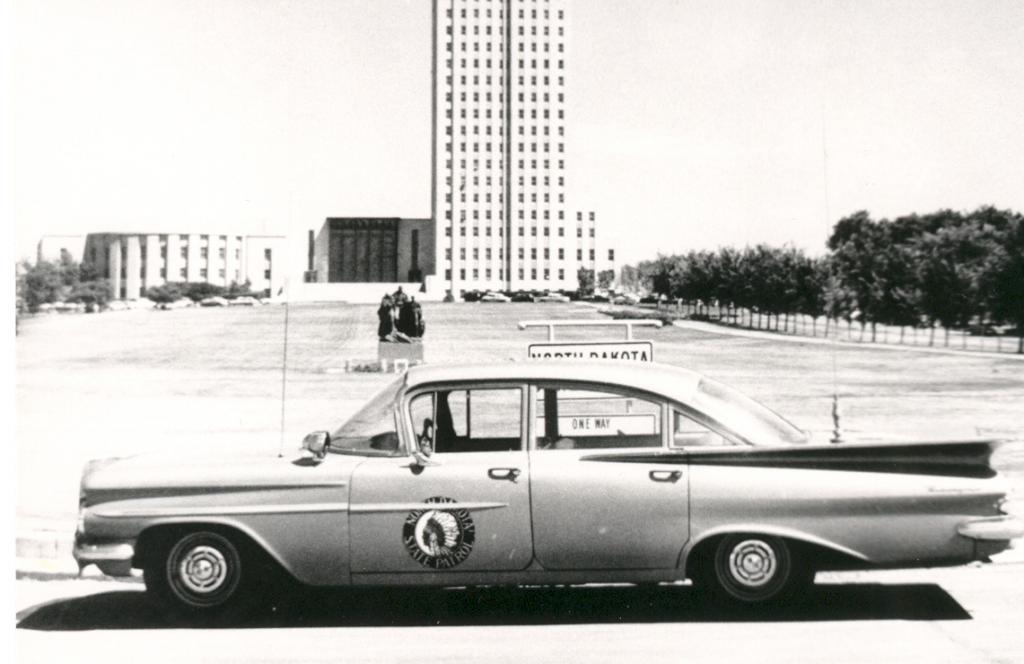
1961 - Property Officer Appointed to Staff
In addition to the superintendent and assistant superintendent, the position of property officer was added to the department staff.
1963 - Increase to 80 Patrol Officers
Two men were added to the department with the creation of the Public Safety Division. The staff position of safety director was created, and this brought the number of sworn personnel in the department to 80.
District commanders were elevated to the rank of captain, and sergeants were created to serve as their assistants.
1964 - Driver License Examiner and Training Officer Appointed
The positions of driver license examiner and training officer were created and added to the department staff.
The superintendent and assistant superintendent were given the rank of colonel and major, respectively.
1965 - Operations Officer Added to Staff
The authority of the Highway Patrol was expanded to include the enforcement of criminal laws at all state institutions.
Employees were authorized to serve in each of the eight district offices as clerks.
The position of operations officer was added to the department staff, and the positions of driver licensing examiner and property officer were abolished.
1966 - Operations and Training Officer Added to the Department
The position of operations and training officer was added to the department staff, and the existing operations officer and training officers were made his assistants.
1967 - Department Expanded to Enforce all Criminal Laws
Department authority was expanded to include the enforcement of all criminal laws on highway right-of-ways.
1969 - Commercial Driver Training Schools
The Patrol was given the responsibility of regulating all commercial driver training schools in the state.
1970 - District Boundaries Reorganized
The department reorganized district boundaries to conform with the governor's regionalization requirements.
The assistant superintendent and the operations and training officers were elevated to the ranks of lieutenant colonel and major, respectively.
1971 - Law Enforcement Training Academy
Responsibilities were expanded to include the operation of the Law Enforcement Training Center. Seventeen training programs were offered at the new facility during the first year of operation.
1973 - Increase to 82 Patrol Officers
The Legislature authorized a total of 82 Highway Patrol officers. The hiring of the additional officers was predicated on enforcement of Public Service Commission rules and regulations.
1975 - Increase to 95 Patrol Officers
After completing a special selective traffic enforcement program which consisted of 13 patrol officers funded by the National Highway Traffic Safety Administration, the Legislature authorized the Patrol to increase its strength.
1978 - Increase to 102 Patrol Officers
The Patrol was authorized to hire an additional seven officers to enforce the 55 miles-per-hour speed limit. National Traffic Highway Safety Administration funded the additional staff for three years.
1979 - Patrol Hires First Female Trooper
Trooper Heidi Sand was hired in 1979. She served North Dakota citizens with the NDHP for five years.
1982 - Civilian Driver License Examiners Hired
Effective May 1, 1982, the North Dakota Highway Patrol relinquished primary responsibility for the administration of driver license examining. Renewal, written, and road test was changed to an instant issue under the supervision of the Highway Patrol. Although the chief driver's license examiner was a uniformed staff officer, the field examiners were civilian personnel.
1983 - Highway Patrol and Truck Regulatory Merger
Effective July 1, 1983, truck regulatory employees were reclassified as Highway Patrol personnel. Uniformed officers would have the powers of a peace officer after mandated training and being sworn. This brought the Highway Patrol's total authorized strength to 125 sworn officers. The Patrol adopted the Motor Carrier Safety Assistance Program (MCSAP). The safety regulations relate to commercial motor carriers.
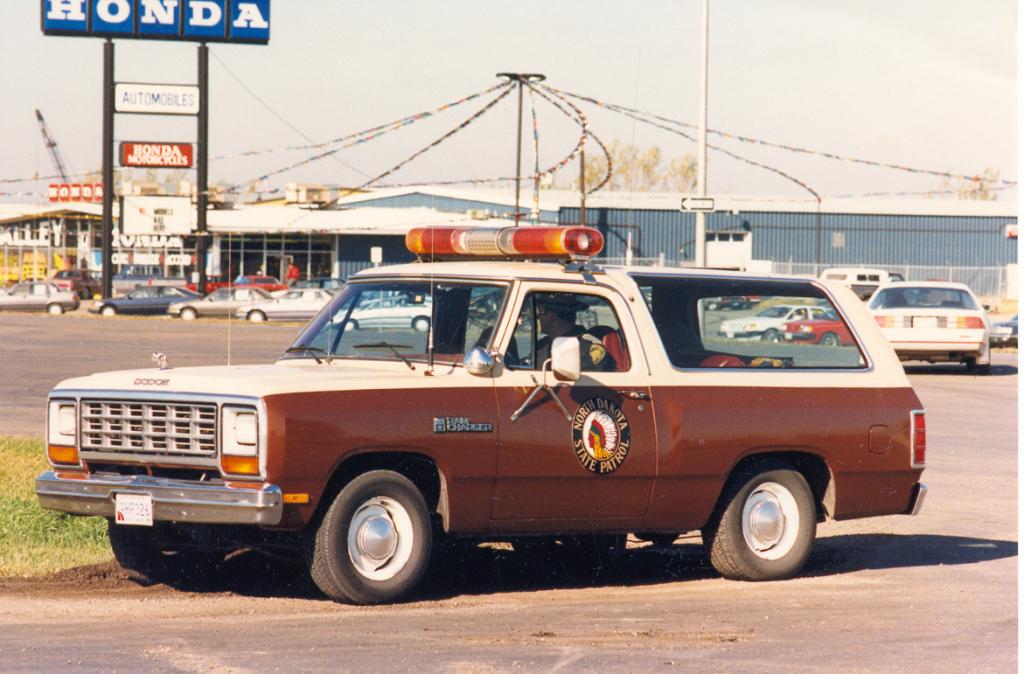
1985 - Highway Patrol Celebrates Golden Anniversary
Several functions were conducted in 1985 in celebration of the department's golden anniversary. Patrol cars were equipped with distinctive license plates; billboards were posted around the state with a safety message in conjunction with identifying the fiftieth year; an open house was held at the district offices; and a departmental banquet was held in Bismarck on September 14, with current members and many former members of the Patrol in attendance.
1985 - TAC Team
A tactical team was created and implemented eventually becoming the emergency response team which primarily focuses on crowd control, search and rescue operations, and dignitary protection.
1986 - Annual Report Reinstated
Reports are generated annually to record our department's activities. View the 1986 Annual Report.
1987 - Driver's Examination Responsibility Removed
Although the Patrol hadn't formally offered driver's license written or road tests since 1982, legislation was enacted removing this responsibility from the Patrol and placing it under the power and jurisdiction of the highway commissioner.
1989 - Highway Patrol Receives National Accreditation Status
The North Dakota Highway Patrol was successful in attaining national accreditation status from the Commission of Accreditation for Law Enforcement Agencies on July 29, 1989. The North Dakota Highway Patrol became the first law enforcement agency in the state of North Dakota to become accredited, and also the eighth state agency and the 109th national agency to receive this status.
1991 - Planning and Research Officer Added to Staff
The position of planning and research officer was added to the department staff.
1992 - Highway Patrol Adds K9 Unit to Force
The Highway Patrol added its first K9 unit to the force. The 1 ½-year-old German shepherd, Shadow, and his handler work out of Linton, ND. Shadow was trained to protect his handler, apprehend people, search buildings and areas, look for evidence, and track. Shadow's assistance was made available to other law enforcement agencies and the general public.
1992 - Two Capitol Security Officers Added
The Highway Patrol added two Capitol security officers to assist with enforcement on the capitol grounds and to provide security for the Supreme Court and during the legislative session.
1994 - Highway Patrol Restructures Organization
Effective January 1, 1994, the North Dakota Highway Patrol reorganized, moving from eight districts to five districts. Each district is overseen by a district commander.
1995 - Increase to 127 Patrol Officers
With the North Dakota Highway Patrol participating in the federal COPS Ahead Program, the agency was authorized to increase sworn officer strength by three, bringing the authorization to 127 sworn officers.
1995 - Low Traffic Fatality Rate
The North Dakota Highway Patrol initiated a special project, "North Dakota 88 Shutdown," in an attempt to keep traffic fatalities below the 88 recorded in 1994. This project involved all law enforcement agencies in the state. Success was met with North Dakota recording 74 traffic fatalities, the fourth-lowest death toll in the state's history.
1996 - Increase to Three K9 Units
Two K9 units, both German Shepherds, were added to the force. Thor and his handler work out of Minot. Chase and his handler work out of Hillsboro. The Patrol's three K9 units play an important role in the Highway Criminal Interdiction Program.
1997 - Increase to 132 Sworn Officers
The Patrol was authorized to increase the sworn officer strength by five. This brought the total authorization of sworn officers to 132.
1999 - Mobile Data Communications System
A detailed, four-year planning process involving leadership from the governor's office, approval of the legislative assembly, and citizen support became a reality with the addition of a mobile data communications system. Sixty-five patrol vehicles were equipped with a high-tech mobile data communications system. The system utilizes a laptop in a wireless environment with the aid of ten tower sites located statewide. The efficiency of this system is recognized through enhanced officer safety, improved communications, reduced data entry/improved data handling efficiency, and reduced dispatcher workload.
2000 - Highway Patrol Restructures Organization
Effective March 1, 2000, the North Dakota Highway Patrol returned to the organizational structure consisting of eight districts with each headed by a district commander.
2000 - Sobriety Checkpoints
In May, the agency held its first sobriety checkpoint. The checkpoints were initiated in an effort to reduce impaired driving and make highways safer.
2001 - Mobile Data Communications System
The Patrol moved into Phase II of the mobile data computer project. This phase included the installation of an additional 20 systems, bringing the total to 95 vehicles equipped with this technology. Five additional tower sites were also included in this phase of the project.
2002 - E-Permits
The Patrol continued to increase its use of electronic technology with the implementation of the E-Permits Application Phase I project. Several types of commercial vehicle permits for the motor carrier industry (fuel, trip, longer vehicle combination, 10% weight exemption for harvest and wintertime, resident custom combiner) went online.
2003 - Increase to 135 Sworn Officers
The Patrol was authorized to increase the sworn officer strength by three. This brought the total authorization of sworn officers to 135.
2003 - Increase to Six K9 Units
The NDHP added four K9s to the department in May of this year: two male black labs, Tyson (Devils Lake), and Smoke (Bismarck), one male chocolate lab named JJ (Fargo), and one female yellow lab named Bailey (Williston). All K9s are dual-purpose; and are trained for narcotics detection, article searching, and tracking. The status of three of the department's K9s changed: Shadow was retired for medical reasons and was replaced with Ricco (Linton), a male Belgium Malinois. Ricco was also certified for aggression and is the only aggression K9 in the department. Thor was also retired this year due to medical reasons and was replaced by a female yellow lab named Sierra (Minot). Chase and his handler are no longer with the department.
2003 - Weigh in Motion (WIM)
Weigh-in-motion technology is a process of screening out legal weight trucks subjecting only potentially overweight trucks to further weighing on portable or fixed scales. Data on vehicle weights is instantaneously made available to troopers through mobile data computers located in their patrol vehicles. This technology was used at four sites on North Dakota's highways. The use of WIM is a joint venture between the NDHP and the NDDOT.
2003 - AMBER Alert Plan
On August 30, 2002, Governor John Hoeven issued Executive Order 2002-06 directing the superintendent of the NDHP, in cooperation with the Division of Emergency Management and other state agencies, local law enforcement, and broadcasters, to develop policies and procedures for child abduction incidents. The plan was fully implemented in February 2003.
2004 - First Woman Promoted to Captain
The North Dakota Highway Patrol promoted Lori Malafa to the rank of captain on April 8, 2004. With the promotion, Malafa was assigned as the training director at the Law Enforcement Training Academy in Bismarck. Captain Malafa was also the first female to be promoted to sergeant.
2004 - DRE Program
A drug recognition expert program was created and implemented to help identify impaired drivers and remove them from our roadways.
2004 - Increase to Nine K9 Units
In April, the NDHP K9 program was expanded to include three additional K9s and handlers, bringing the total to nine teams.
2005 - Operation Border Shield
Operation Border Shield was developed to assist the US Customs Border Protection and US Border Patrol in the security of the northern border. The program targeted the ports of entry to detect and apprehend criminals and contraband through the use of NDHP K9 teams. K9 teams assisted the immigrations and customs enforcement personnel in searching vehicles and persons during peak travel times identified by Custom Border Protection officials.
2005 - Capitol Security
In 2005, all security duties for the capitol were placed under the direction of the Highway Patrol. A director of security was appointed with four full-time and four part-time employees assigned to the capitol security function. A new duress alarm system was installed in the Capitol and surrounding state office buildings as well as additional video cameras. In July, capitol security equipped a Smith and Wesson tactical mountain bike with lights and a siren for special events and security patrolling during the summer months.
2007 - Increase to 140 Sworn Officers
The Patrol was authorized to increase the sworn officer strength by two. This brought the total authorization of sworn officers to 140. (In 2004 and 2006, three authorized non-sworn positions were transferred to sworn positions.)
2007 - NDHP Restructures Organization
The North Dakota Highway Patrol made an organizational structure change going from eight districts to four regions with all eight of the former district offices remaining in place. Each region is headed by an administrative commander and also includes an operations commander. The reorganization also created a new Motor Carrier Operations component which includes personnel involved with commercial motor vehicles.
2008 - NDHP Airplane Upgrade
The Highway Patrol purchased a 2007 Cessna T 206 airplane equipped with G1000 Garmin avionics and forward-looking infrared technology (FLIR). The airplane will be used to assist with search and rescue operations; conduct aerial searches after natural and man-made disasters; assist ground officers during pursuit operations; assist various state, local, and federal agencies; transport department personnel; and other law enforcement functions.

2010 - 75th Anniversary
The ND Highway Patrol celebrated 75 years of service since the agency was created by the 1935 Legislative Assembly.

2010 - Crash Reconstruction Team (CRT)
A crash reconstruction team was created and implemented consisting of crash reconstructionists and technicians to more efficiently process serious crashes. Crash reconstructions assist in both criminal and civil proceedings, and help bolster personal responsibility while operating a vehicle.
2012 - Accreditation
The NDHP received its eighth accreditation award.
2013 - Automated Routing
An automated routing permitting system was implemented to process routes for oversize and overweight vehicles online.
2013 - Honor Guard Team
The ND Highway Patrol honor guard team was created and implemented to assist with special ceremonies and funerals.
2013 - Bloodhound Team
A bloodhound team was added to the K9 program to assist with human tracking.
2014 - Divisions
The agency was reorganized into five divisions with three in field operations (west, east, and motor carrier) and two in administration (support services and administrative services).
2015 - Training Facilities
The construction of a new emergency vehicle operations driving pad and indoor firing range was completed on land donated by the City of Bismarck. The City also transferred an existing outdoor firing range to the NDHP.
2015 – Accreditation
The NDHP received its ninth accreditation award.
2017 - Enhanced Training
The NDHP purchased a skid car system for improved emergency vehicle operations training. All sworn officers were certified in the use of less lethal munitions, and emergency response team members were certified as grenadiers.
2017 - Emergency Declaration
The NDHP supported Morton County with public safety efforts during the construction of the Dakota Access Pipeline. An emergency declaration was signed by Governor Jack Dalrymple on August 19, 2016, and a mandatory evacuation was signed by Governor Doug Burgum on February 15, 2017.
2017 - CLO Program
A cultural liaison officer position was added to the NDHP to assist with strengthening relationships with tribal nations and new Americans.
2017 - Vision Zero
The department of transportation, department of health, and highway patrol were selected as lead agencies for a new Vision Zero initiative in North Dakota. The goal of Vision Zero is zero fatalities and serious injuries on North Dakota roads. In order to reach that goal, every driver and vehicle occupant must take personal responsibility for their safety.
2018 - Gold Standard
The NDHP received its tenth accreditation award with excellence, successfully obtaining its first “Gold Standard” assessment.
2018 - Patrol Vehicles
The NDHP began a transition to black patrol vehicles with a logo on each door.
2018 - Youth Academy
The NDHP youth academy was re-instated to help spark interest in the highway patrol and a career in law enforcement for ages 16-19.
2019 - NDHP Jurisdiction
The NDHP worked with multiple agencies to enhance the NDHP’s jurisdiction. For example, troopers now have jurisdiction on private property for any crime that occurs in their presence and when responding to a call for emergency assistance.
2019 - UAV Program
The NDHP developed an unmanned aerial vehicle (UAV) program to assist with crash investigations and search and rescue operations. The NDHP was the first state highway patrol agency in the nation to receive a waiver to operate UAVs over people.
2019 - DRE/SFST Coordinator
An NDHP trooper was selected to serve as the statewide drug recognition expert and standardized field sobriety testing coordinator for peace officers in North Dakota.
2019 - Eight States Conference
The NDHP hosted the Eight States Conference in Grand Forks. This conference is comprised of state or highway patrol leaders from Colorado, Idaho, Montana, Nebraska, North Dakota, South Dakota, Utah, and Wyoming.
2020 - Wellness Committee Formation
The NDHP created a wellness committee focused on the physical, social, mental, emotional, and financial health of employees and their family members.
2020 - Project Find Safe
The NDHP assisted in the development of the Project Find Safe program in collaboration with Minot State University. The program equips public safety agencies with training and technology to assist in locating at-risk individuals prone to the life-threatening behavior of wandering.
2021 - MHA Nation Law Enforcement Agreement
The first tribal agreement for mutual law enforcement services was signed with MHA Nation.
2021 - Crash Assistance Program
The NDHP started a two-member crash assistance program focused on victim services and employee wellness.
2021 - Criminal Interdiction Team
A five-member criminal interdiction team was created comprised of four troopers and one sergeant.
2022 - 30 x 30 Pledge Signed
The NDHP signed the 30x30 pledge, a nationwide initiative whose goal is to increase the representation of women in law enforcement recruit classes to 30% by the year 2030 and to ensure agency policies and culture intentionally support the success of qualified women officers throughout their careers.
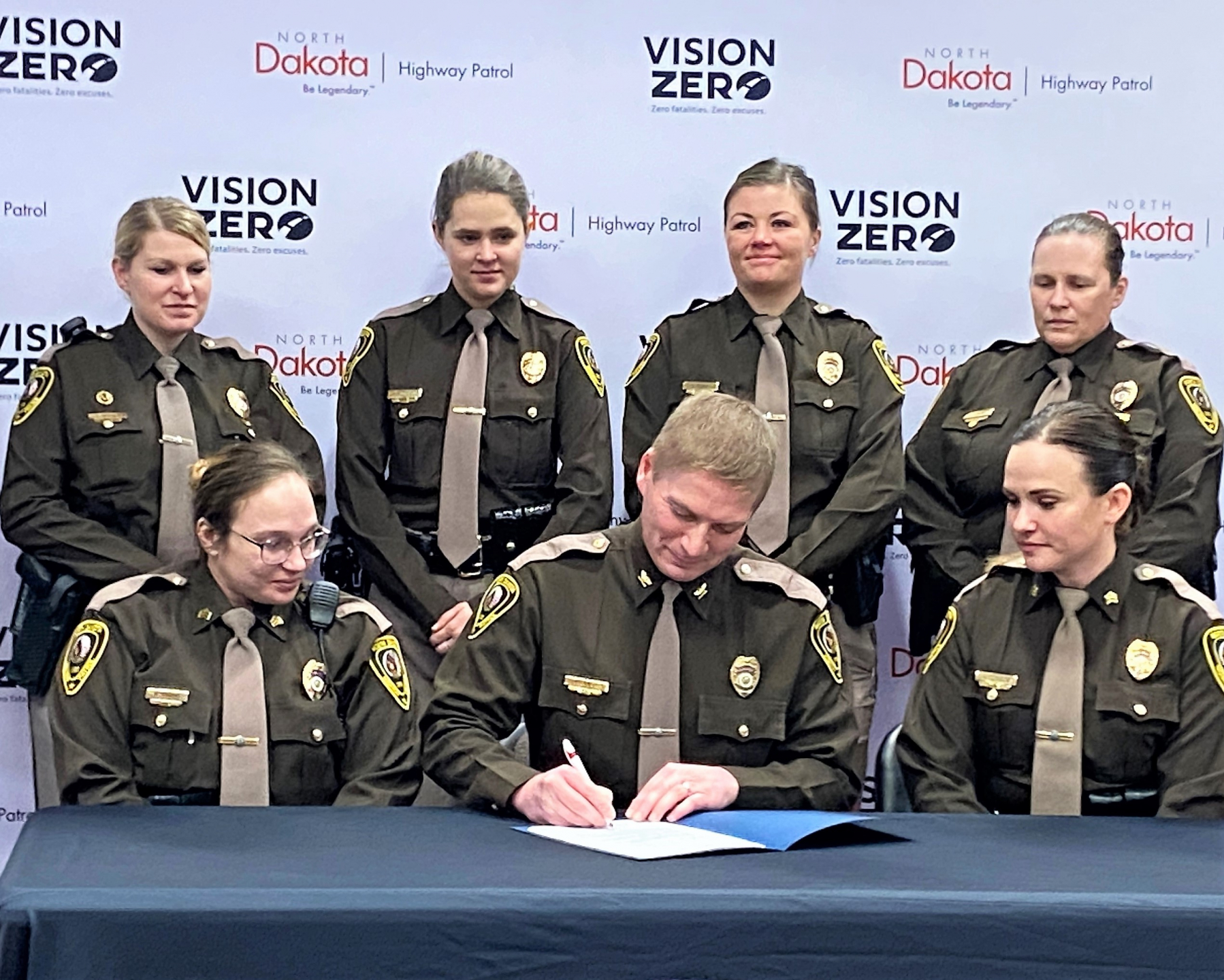
2022 - Opioid Roundtables
The NDHP partnered with police chiefs in Bismarck, Minot, Grand Forks, and Fargo to host roundtables bringing together local leaders, legislators, and public safety and public health partners to discuss strategies to address opioids and overdoses.
2022 - American Governors’ Border Strike Force
North Dakota joined 25 other states to form the American Governors’ Border Strike Force and conducted a first-of-its-kind multi-state law enforcement operation focused on combating human and drug smuggling, disrupting transnational criminal organizations, and protecting our communities.
2022 - Spirit Lake Tribe Law Enforcement Agreement
A tribal agreement for mutual law enforcement services was signed with Spirit Lake Tribe.
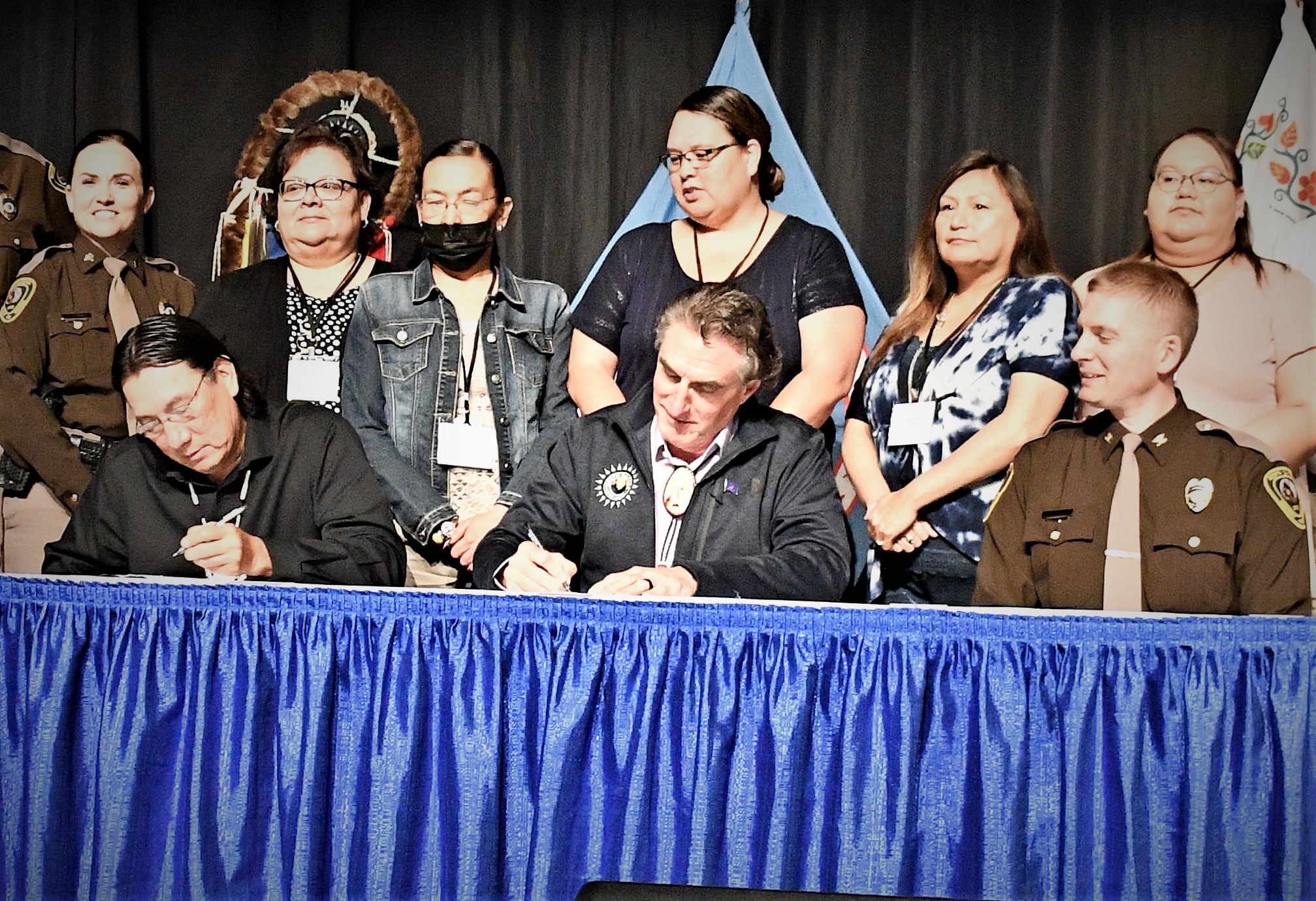
2022 - Less Conspicuous Patrol Vehicle
The NDHP deployed a less conspicuous patrol vehicle in the Fargo area to make it easier for troopers to detect aggressive drivers and crash-causing violations such as excessive speed and distracted driving.
2022 - 11th Accreditation Award
The NDHP was awarded advanced accreditation by the Commission on Accreditation for Law Enforcement Agencies. The NDHP received meritorious recognition for being accredited for more than 15 continuous years.
2023 - Clinical Mental Health Network
The NDHP worked with the department of health and human services to formalize a clinical mental health network comprised of 12 clinicians to provide all state law enforcement officers access to counselors statewide.
2023 - Additional Troopers
Twelve new trooper positions were authorized including four additional criminal interdiction members to expand the team into all four regions of the state. An accelerated training program was created to recruit licensed peace officers, and 19 new troopers graduated on January 26 which equated to 20% of the NDHP’s total traffic enforcement troopers.
2024 - LETA Remodel
A $3 million appropriation was used to modernize the North Dakota Law Enforcement Training Academy. Projects included enhancements to the kitchen, dorm rooms, and bathrooms.

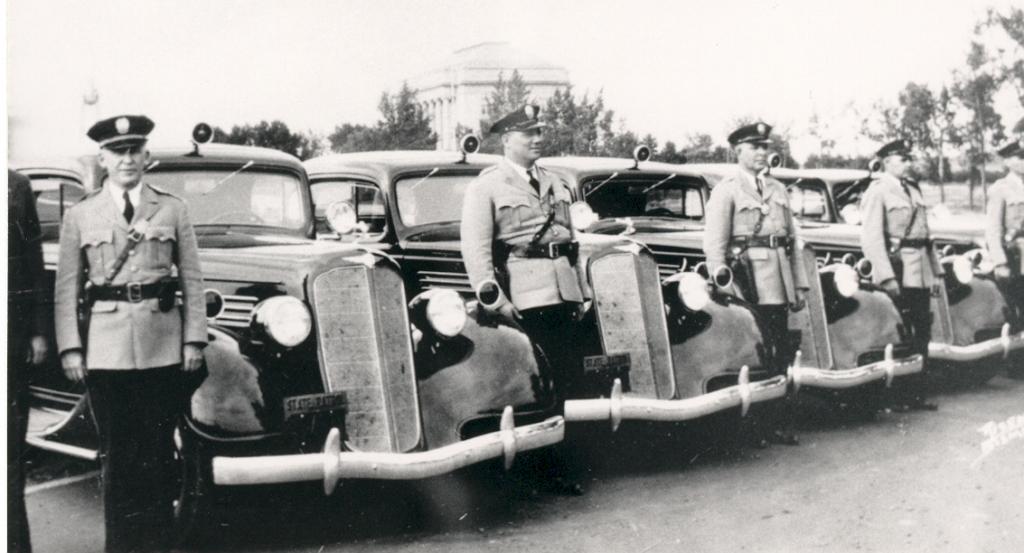
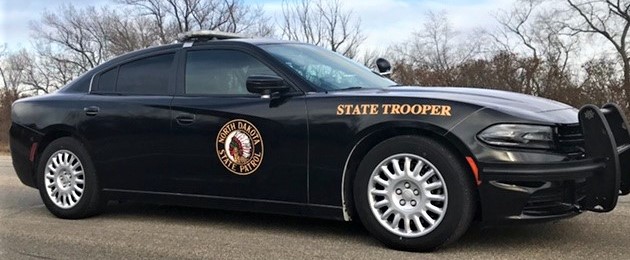
.JPG)
